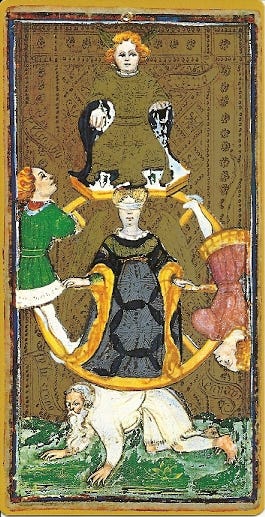Hello everyone—and a special welcome to new readers.
I wasn’t able to publish EP on a regular schedule the past few weeks, so I’m making up with a week-long series of daily emails. I used to do this once in a while, under the heading “Daily Notes”—but now that Substack calls its social media component “Notes,” I decided to avoid any confusion and name this new series “Daily Dispatches” instead.
I have in mind a mix of older posts worth revisiting, current news from the Tarot community, and ideas/events that capture my attention along the way. Plus a few announcements.
So tomorrow I’ll go further afield. But today I want to reshare some of a post I wrote in April of 2022, relating to Russia’s then-recent assault on Ukraine. I was thinking at the time about the fact that Tarot seems to have appeared just at the end of the Hundred Years War (1337–1453)—a series of inter-connected conflicts that raged across Europe for over a century, killing at least two million people.
If you’d like to read the whole post, it’s free this week.
But I want to highlight the following portion, because I think it pertains to the present point in time. A point at which many of us are increasingly concerned about what’s happening in the world—not just in distant countries, but on our own shores . . . .
We are watching a strange proof of why Tarot is so powerful.
It’s a prevalent assumption that the original Tarot images were shaped by a pervasive Catholic religiosity. I could offer a dispute, but let’s not bother. After all, religious zeal—along with thirst for power, material greed, hubris, and ideological obsession—is one of the threads permanently intertwined in warfare, from the Siege of Troy to Russia’s most recent invasion of Ukraine.
So it’s all the same story. And that story is condensed into the Tarot. Intentionally or otherwise, it doesn’t matter.
The “plot” of the story is not circumstantial, it is archetypal. That means it will play out along lines that are predetermined—by fate, by human nature, or however you want to look at it. And it has never ended, just paused.
We are presently watching the same chain of events that has transpired over millennia in different forms. But like everything else in modern life, it is now speeded up, and magnified. So we have a time-lapse view of this archetypal process. Plus a fore-knowledge of its outcome.
Not one war in history has ended cleanly, or left the world in a better place. People just stop for a while, nurse their grievances, plot their revenge, and look for the next excuse or provocation. Not everyone, of course—but a majority.
In the last couple of centuries, there have been efforts to prevent the next round of bloodshed, and we even see a little progress in that direction. But it’s a very steep uphill journey. And in a sense . . . Tarot tells us why this is so.
Every trump is like a see-saw, tipping from light to dark. The Fool is a sage or an idiot, The Chariot is constructive or destructive energy, The Star could be aspiration or delusion. And so on.
Since entropy always tends toward disorder (that’s why a broken egg cannot become unbroken), every time you put the seesaw back into balance, it will stay that way for a while, then slowly tip toward darkness and disorder. Exactly the same thing happens in the lives of individuals, and of nations.
We can level out the see-saw, time after time. But since combatting entropy uses more energy than just going along, it takes a lot of effort. And humans (as a species) don’t work that hard proactively. They wait until there is no choice.
So here we are, again.
Closing thought: Tarot is arguably the best of all divinatory tools, though that is only one use. It works for many purposes because the Major Arcana provides us with a condensed catalog of the cosmos, depicting every element I can think of—and it is utterly realistic about the mixture of goodness and evil that makes up our world.
For that reason, we can use it to study anything realistically. Even war.
We can also use it to evade reality, by pushing down on the light side of the see-saw, and insisting on a happy meaning for every card. But that seems like a waste.
See you tomorrow. C



